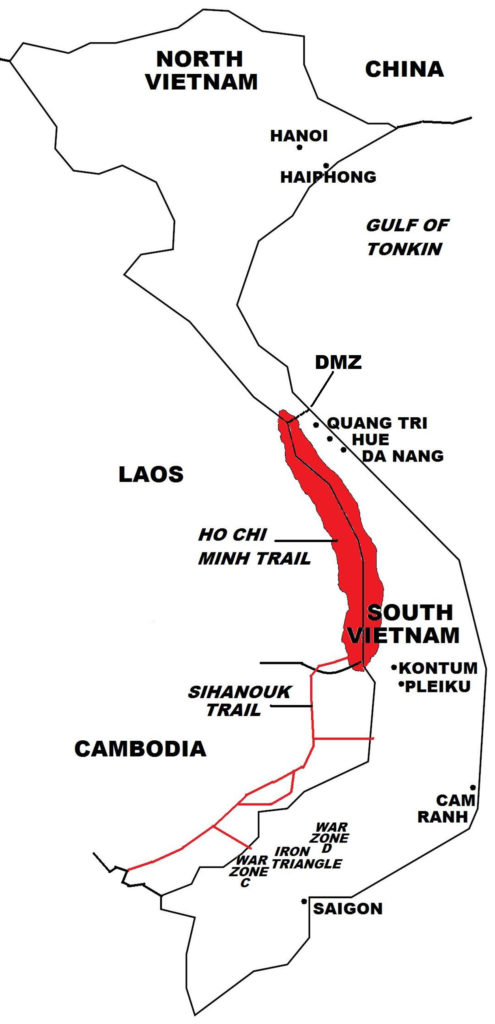In January 1959, North Vietnam agreed to provide military support to the Viet Cong. In May of that year, it formed the 559th Transportation Group of the North Vietnamese Army, which was tasked to establish a supply route to South Vietnam. This supply route, which initially passed directly through the DMZ, was intercepted by South Vietnamese forces. North Vietnam then moved its supply route to eastern Laos and Cambodia, where manpower and war materials were transported to the Viet Cong in South Vietnam. The supply route that developed, which became known as the Ho Chi Minh Trail, was located close to the shared borders of Vietnam, Laos, and Cambodia, and initially consisted of foot tracks in sparsely inhabited rugged mountains that were covered in the dense canopy of tropical rainforests. One year earlier (May 1958), North Vietnamese forces had crossed over into and occupied sections of eastern Laos, including the strategically placed Tchepone in Savannakhet Province, in support of the Pathet Lao, a Laotian communist movement that was fighting a revolutionary war in Laos against the West-aligned Royal Lao Government.

Within a few months after Group 559’s formation, weapons and supplies from North Vietnam were being transported in large quantities through the Ho Chi Minh Trail to the insurgents in South Vietnam. As well, the first batches of Viet Minh southerners who had moved to North Vietnam following the Geneva Accords and were now officers and soldiers of the North Vietnamese Army, were trekking down the Ho Chi Minh Trail toward South Vietnam, where they would serve as the leaders and advisers of, or otherwise joined the ranks of, the Viet Cong.
Background In July 1954, the First Indochina War ended with the Geneva Accords, which partitioned the French colony of Vietnam into two military zones at the 17th parallel, the northern and southern zones. The northern zone was assigned to and occupied by the Democratic Republic of Vietnam (DRV). The DRV was led by the Viet Minh (Vietnamese: Việt Nam Độc Lập Đồng Minh Hội, or “League for the Independence of Vietnam”), a nationalist communist-led organization headed by the revolutionary Ho Chi Minh, who had fought to end French colonial rule in Vietnam. The southern zone was assigned to the French-established State of Vietnam.
The Geneva Accords stipulated that Vietnam’s partition at the 17th parallel was only a temporary expedient to separate the warring sides. The 17th parallel was designated as a demilitarized zone (DMZ) of 6 miles wide (3 miles on both sides of the line), and was not a political/territorial boundary, and the reunification of the two halves of Vietnam was to be undertaken after nationwide elections could be held in July 1956. However, the reunification elections did not take place, and the DRV in the northern zone and the State of Vietnam in the southern zone became de facto separate states, with the former becoming more widely known as North Vietnam, and the latter known as South Vietnam.
In Hanoi, the capital of North Vietnam, Ho and his DRV government consolidated power and established a Marxist state. All lands and industries were nationalized, agrarian reform was implemented, and dissent suppressed. As in the First Indochina War, North Vietnam received military and economic support from the People’s Republic of China (PRC) and the Soviet Union. In South Vietnam, which officially was a democracy based along Western lines, Prime Minister Ngo Dinh Diem only gradually consolidated power. In April 1955, Diem launched military campaigns to suppress the militant religious groups, Cao Dai and Hoa Hao, and the organized crime syndicate, Binh Xuyen. These operations were successful, but only after some intense fighting in the capital, Saigon, that left hundreds of people dead and thousands of others homeless. Then in October 1955, to determine South Vietnam’s political future, a referendum (which the government manipulated using fraud) showed that the South Vietnamese overwhelmingly favored setting up a republic, and rejected the return of the monarchy. Following the referendum, Diem declared the formation of the Republic of Vietnam (South Vietnam) and named himself as its (first) President. Thereafter, President Diem reached the peak of his political power, although his government became mired in corruption, nepotism, and stagnation. Diem soon also repressed all forms of political dissent.
Also in 1955, President Diem launched a suppression campaign against the re-emerging communist movement in South Vietnam, and in August 1956, instituted the death penalty for persons being involved in communism. In the aftermath of the Geneva Accords, some 100,000 Viet Minh southerners migrated to North Vietnam, although about 10,000 Viet Minh southerners, with the encouragement of the North Vietnamese leadership, remained in South Vietnam. These stay-behind Viet Minh communists carried out political activism using front organizations, such as religious, farmers, students, workers, and women groups, in order to conceal their political objectives, and also to appeal to a wider segment of the population.
In March 1956, the fledging South Vietnamese insurgency asked for military support from North Vietnam, which was turned down by the Ho government, because China and the Soviet Union were reluctant to becoming involved in another potentially costly war so soon after the recent Korean War (which just ended nearly three years earlier, in July 1953). But in December 1956, when reunification of Vietnam became unlikely and North Vietnam and South Vietnam were forming separate states, North Vietnam agreed to provide only limited support to the insurgents.
In 1957, the South Vietnamese insurgents, whom the Saigon government called Viet Cong (Vietnamese communists; a contraction from the Vietnamese: Việt Nam Cộng-sản), unleashed a wave of violence in South Vietnam, with many incidents of assassinations, murders, bombings, and other terrorist acts taking place. By 1958, the Viet Cong had established a command structure, with militias organized into a regular army-type organization. For more information on this war, click here.
